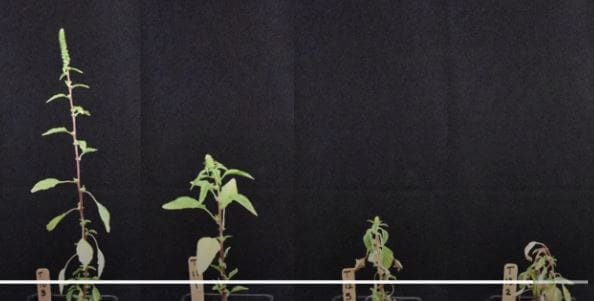DRIVING across Iowa, distinguished professor of chemical and biological engineering at the University of Nebraska in the United States, Hendrik J. Viljoen, noticed that soybean fields were becoming increasingly infested with weeds each season.
The culprit is a glyphosate-resistant weed, palmer amaranth, which is threatening crops in the Midwest.
One pesticide currently used for controlling palmer amaranth is Dicamba, but it has devastating effects on adjacent areas, harming trees and other crops, because it tends to drift when sprayed during windy conditions.
As a firm believer in the concept that our well-being is closely tied to the health of the crops and animals within our food chain, Viljoen reports in the journal Physics of Fluids, from AIP Publishing, that he was inspired to create a way to spot treat weeds that eliminates any risk of pesticide drift.
“A pesticide solution can be stabilised on a rotating horizontal cylinder/roller akin to a wooden honey dipper,” Viljoen said.
“Its stability depends on the speed at which the applicator rotates. But the roller is only one part of a bigger process, and there are some technical details regarding the roller that we’re also addressing, namely replenishing the pesticide load via wicking from a reservoir at the centre of the cylinder.”
The manner in which pesticides are applied to plants makes a difference. They can be sprayed from the top of the leaf, rolled on, or delivered by a serrated roller to simultaneously scuff it and apply the pesticide.
“We will only arrive at an optimum design if we understand how the active ingredient in the pesticide is delivered to the weed, how it enters the phloem (the plant’s vascular system that transports the active ingredient), and the efficacy of its killing mechanism,” Viljoen said.
To apply the pesticide to weeds, rollers can be mounted onto small robots or tractors.
“Our current research objective is to develop a system where unmanned aerial vehicles image fields and feed the images to trained neural networks to identify the weeds,” he said.
“The information on weed species and their exact location will then be used by the robots to spot treat the weeds.”
One key finding by Viljoen’s group is that the preferred way to operate the roller is to rotate it so that the original velocity at the roller’s underside coincides with the direction the robot is traveling.
They’re now doing experiments to determine any uptake bias for palmer amaranth, as well as exploring making part of the roller’s surface serrated.
“The idea is to physically penetrate the epidermis to enhance the amount of active ingredient that’s delivered to the weed,” he said.
“To broaden our understanding, we’ve developed a mathematical model of the transport of the pesticide in the phloem.”
The significance of this work is that while there’s increasing pressure to produce enough food for a growing population, the current approach is unsustainable.
The trend today is to use increased amounts and more potent chemicals to control weeds and invasive species that have developed resistance to previously effective pesticides.
“We must minimise the impact of our practices on the environment and reduce the use of chemicals, their residues and metabolites within our food chain and on the greater ecology,” Viljoen said.
“Technologies exist that can help us achieve these goals. Precision spray technologies use artificial intelligence to identify weeds and only spray specific areas, but we can do better. We should eliminate the risk of drift and minimise exposure of crops and soil to pesticides.”
Developing a drift-free, weed-specific applicator will pave the way for autonomous weed control with smart robots.
“At this stage, we can’t envision the full utility of these robots, but they offer us the opportunity to survey fields and alert us to disease breakouts, blights or nematodes,” Viljoen said.
“In the future, the roller – with some modifications – could also be used to deliver small RNA molecules to plants. Smaller farm operations that focus on specialised products will likely be the first adopters of the technology.”
Videos
The two videos below compare the results of the glyphosate-resistant palmer amaranth plants for different application methods and different pesticides. Each plant was photographed daily for a period of 21 days. Video 2: This video shows the response of glyphosate-resistant palmer amaranth plants to treatment with (left to right) water (control), glyphosate, Dicamba, and 2,4-D, applied with a serrated roller. The concentrations were tenfold higher than spray concentrations.
Video 1: https://www.eurekalert.org/multimedia/pub/196802.php?from=425149
Video 2: https://www.eurekalert.org/multimedia/pub/196803.php?from=425149
(Credit: Hendrik Viljoen)
Source: American Institute of Physics
The article, “Stability analysis of a thin film on a rotating cylinder with low airflow,” is authored by Heather Newell and Hendrik J. Viljoen. It appeared in Physics of Fluids on March 12, 2019 (DOI: 10.1063/1.5080443). The article can be accessed at http://aip.scitation.org/doi/full/10.1063/1.5080443.
https://www.eurekalert.org/pub_releases/2019-03/aiop-awc032719.php


HAVE YOUR SAY